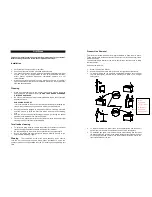
Moving:
Disconnect the power cord plug from the wall outlet.
Remove foods, then defrost, and clean the freezer.
Secure all loose items such as baskets and fix the lids by taping them securely
in place to prevent damage.
In the moving vehicle, secure freezer in an upright position, and secure to
prevent movement. Also protect outside of freezer with a blanket, or similar
item.
Power Failure/Freezer Failure
NOTE: Do not open freezer door unnecessarily if freezer is off for several
hours.
If a power failure occurs,
frozen foods will stay frozen for at least 2 hours if
the freezer is kept closed. If the power failure continues, pack seven or eight
pounds of dry ice into the freezer every 24 hours. Place over the product a thick
cardboard or one inch polyurethane sheet and close the lids. Look in the Yellow
Pages under "Dry Ice," "Dairies," or "Ice Cream Manufacturers" for local dry ice
suppliers. Always wear gloves and use caution when handling dry ice.
If the freezer has stopped operating,
see "Freezer does not run" in the Avoid
Service Checklist Section of this manual. If you cannot solve the problem, call
an authorized servicer immediately. Do not allow inexperience people to repair
or modify the electrical wiring and/or refrigeration components.
If the freezer remains off for several hours, follow the directions above for the
use of dry ice during a power failure. If necessary, take the food to a local
locker plant until the freezer is ready to operate. Look in the Yellow Pages
under "Frozen Food Locker Plants."
Avoid Service Checklist
Avoid Service Checklist
Before calling for service, review this list. It may save you both time and expense. This
list includes common occurrences that are not the result of detective workmanship or
materials in this appliance.
OCCURRENCE
FREEZER DOES NOT RUN
SOLUTION
Check to ensure that freezers are not plugged into a circuit that has ground fault interrupt.
If you are unsure about the outlet, have it checked by a certified technician.
Temperature control is in the OFF position. See Setting the Temperature Control Section.
Freezer may not be plugged in, or plug may be loose. Be sure plug is tightly pushed into
electrical outlet.
House fuse has blown, or circuit breaker has tripped. Check/reset circuit breaker, or
replace fuse with 15 amps. Time delay fuse
Power outage. Check house lights. Call local electric company.
Freezer runs too much or too long
Room or outside weather is hot. It is normal for the freezer to work harder under these
conditions.
Freezer had recently been disconnected for a period
of time
. Freezer requires 4 hours to
cool down completely.
Large amounts of warm or hot product have been stored recently. Warm product will
cause the freezer to run more until the desired temperature is reached.
Door is kept open too long or too frequently. Warm air enters the freezer every time the
door is opened. Open the door less often.
Freezer door may be slightly open.
Temperature control is set too cold. Turn the control knob to a warmer setting. Allow
several hours for the temperature to stabilize.
Temperatures inside the freezer are
too cold
Temperature control is set too cold. Turn the control to a warmer setting. Allow several
hours for the temperature to stabilize.
Temperatures inside the freezer are
too warm
Temperature control set too warm. Turn the control to a colder setting. Allow several
hours for the temperature to stabilize.
Door is kept open too long or is opened too frequently. Warm air enters the freezer every
time the door is opened. Open the door less often
Door may be open slightly.
Freezer has recently been disconnected for a period of time. Freezer requires 4 hours to
cool down completely.
Temperature
of
external
freezer
surface is warm
The exterior freezer walls can be as much as 30° F warmer than room temperature. This
is normal while the compressor works to transfer heat from inside the freezer cabinet.
SOUND AND NOISE
The fan motor in the compressor compartment is damaged or has a loose connection
Louder sound level whenever freezer
is on
Modern freezers have increased storage capacity and more even temperatures. They
require a high efficiency compressor. When the surrounding noise level is low, you might
hear the compressor running while it cools the interior.
Louder sound levels when compressor
comes on
Freezers operate at higher pressures during the start of the ON cycle. This is normal.
Sound will level off or disappear as freezer continues to run.
Popping or cracking sound when
compressor comes on
Metal parts undergo expansion and contraction, as in hot water pipes. This is normal.
Sound will level or disappear as freezer continues to run.
Bubbling or gurgling sound, like water
boiling
Refrigerant (used to cool freezers) is circulating throughout the system. This is normal.
Vibrating or ratting noise
Freezer is not level. It rocks on the floor when it is moved slightly. Level the unit.
Floor is uneven or weak. Freezer rocks on the floor when it is moved slightly. Be sure
floor can adequately support freezer. Level the freezer by putting wood or metal shims
under art of the freezer.
Moisture forms on inside freezer walls
Weather is hot and humid, which increases internal rate of frost build-up. This is normal.
Door is slightly open.
Door is kept open too long, or is opened too frequently.
Door is slightly open, causing the cold air from inside the freezer to meet warm moist air
from outside.
ODOR IN FREEZER
DOOR PROBLEMS
Interior needs to be cleaned. Clean interior with sponge, warm water, and baking soda.
Product with strong odors is in the freezer. Cover the product tightly.























